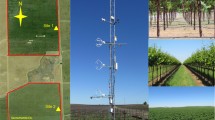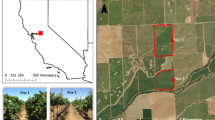Abstract
The seasonal characterization of spatial variability in water requirements across and within vineyards could assist the viticulturist to fine-tune irrigation management for quality optimization. Remotely sensed crop water stress index (CWSI) is related to crop water status, but it is not known how applicable it is to different grape varieties at different times of the season. This study focused on the determination of the lower and upper baselines for calculating CWSI for the Chardonnay, Pinot-noir, Syrah and Tempranillo varieties at different phenological stages. Baselines were determined based on canopy temperatures measured with infrared temperature sensors placed on top of well-watered grapevines in 2011. Results indicated that non-water-stressed baselines differed depending on variety and phenological stage. During 2011, an aircraft equipped with a thermal camera flew over the vineyards on six particular days throughout the season at 150 m altitude above ground level. At the same time, leaf water potential (Ψ L) was measured for each variety. Variety and phenological stage affected the relationship between remotely sensed CWSI and Ψ L, with phenology having greater influence on the observed measurements than on variety. For instance, the one-to-one relationship between estimated and measured Ψ L had R 2 of 0.634 and 0.729 for variety and phenology, respectively. The baselines and estimations of Ψ L were validated in different vineyards of the same region and in a different season (2013) using the same methodology as in 2011. Data obtained in 2013 were in agreement with observations during 2011. It is concluded that the use of CWSI for assessing vineyard water status requires calibration to account for the effects, primarily of phenological stage, but also, of variety. Once calibrated, this can be successfully applied to other vineyards and seasons.








Similar content being viewed by others
References
Alsina MM, de Herralde F, Aranda X, Savé R, Biel C (2007) Water relations and vulnerability to embolism are not related: experiments with eight grapevine cultivars. Vitis 46(1):1–6
Bellvert J, Zarco-Tejada PJ, Girona J, Fereres E (2014) Mapping crop water stress index in a `Pinot-noir´ vineyard: comparing ground measurements with thermal remote sensing imagery from an unmanned aerial vehicle. Precis Agric 15:361–376
Berni JJ, Zarco-Tejada PJ, Sepulcre-Cantó G, Fereres E, Villalobos F (2009a) Mapping canopy conductance and CWSI in olive orchards using high resolution thermal remote sensing imagery. Remote Sens Environ 113:2380–2388
Berni JA, Zarco-Tejada PJ, Suarez L, Fereres E (2009b) Thermal and narrow-band multispectral remote sensing for vegetation monitoring from an unmanned aerial vehicle. IEEE Trans Geosci Remote Sens 47:722–738
Clawson KL, Jackson RD, Pinter PJ (1989) Evaluating plant water stress with canopy temperature differences. Agron J 81:858–863
Costa JM, Ortuño MF, Lopes CM, Chaves MM (2012) Grapevine varieties exhibiting differences in stomatal response to water deficit. CSIRO publishing. Funct Plant Biol 39(3):179–189
Field CB (1987) Leaf-age effects on stomatal conductance. In: Zeiger E, Farquhar GD, Cowan IR (eds) Stomatal function. Stanford University Press, Stanford, pp 367–384
Gates DM, Papian LE (1971) Atlas of energy budgets of plant leaves. Academic Press, New York
Girona J, Mata M, del Campo J, Arbonés A, Bartra E, Marsal J (2006) The use of midday leaf water potential for scheduling deficit irrigation in vineyards. Irrig Sci 24:115–127
Hipps L, Asrar G, Kanemasu E (1985) A theoretically-based normalization of environmental effects on foliage temperature. Agric For Meteorol 35:113–122
Idso SB, Jackson RD, Pinter PJ, Reginato RJ, Hatfield JL (1981) Normalizing the stress-degree day parameter for environmental variability. Agric Meteorol 24:45–55
Jackson RD, Idso SB, Reginato R, Pinter PJ (1981) Canopy temperature as a drought stress indicator. Water Resour Res 17:1133–1138
Jackson RD, Kustas WP, Choudhury BJ (1988) A re-examination of the crop water stress index. Irrig Sci 9:309–317
Leinonen I, Jones HG (2004) Combining thermal and visible imagery for estimating canopy temperature and identifying plant stress. J Exp Bot 55(401):1231–1243
Marsal J, Girona J (1997) Relationship between leaf water potential and gas exchange activity at different phenological stages and fruit loads in peach trees. J Am Soc Hortic Sci 122(3):415–421
McCutchan H, Shackel K (1992) Stem-water potential as a sensitive indicator of water stress in prune trees (Prunus domestica L. cv. French). J Am Soc Hortic Sci 117(4):607–611
Meron M, Tsipris J, Charitt D (2003) Remote mapping crop water status to assess spatial variability of crop stress. In: Stafford J, Werner A (eds) Precision agriculture. Proceedings of the 4th European conference on precision agriculture. Academic Publishers, Berlin, pp 405–410
Möller M, Alchanatis V, Cohen Y, Meron M, Tsipris J, Naor A, Ostrovsky V, Sprintsin M, Cohen S (2007) Use of thermal and visible imagery for estimating crop water status of irrigated grapevine. J Exp Bot 58(4):827–838
Nobel PS (2009) Physiochemical and environmental plant physiology, 4th edn. Academic press, Amsterdam 582
Olivo N, Girona J, Marsal J (2009) Seasonal sensitivity of stem water potential to vapour pressure deficit in grapevine. Irrig Sci 27(2):175–182
Poni S, Bernizzonia F, Civardia S, Gattia M, Porro D, Caminc F (2009) Performance and water-use efficiency (single-leaf vs. whole-canopy) of well-watered and half-stressed split-root Lambrusco grapevines grown in Po Valley (Italy). Agric Ecosyst Environ 129:97–106
Pou A, Medrano H, Tomàs M, Martorell S, Ribas-Carbó M, Flexas J (2012) Anisohydric behaviour in grapevines results in better performance under moderate water stress and recovery than isohydric behaviour. Plant Soil 359:335–349
Rogiers SY, Greer DH, Hatfield JM, Hutton RJ, Clarke SJ, Hutchinson PA, Somers A (2012) Stomatal response of an anisohydric grapevine cultivar to evaporative demand, available soil moisture and abscisic acid. Tree Physiol 32(3):249–261
SAS (2002) Enterprise guide version 42. SAS Institute Inc., Cary
Schultz HR (2003) Differences in hydraulic architecture account for near-isohydric and anisohydric behavior of two field-grown Vitis vinifera L. cultivars during drought. Plant Cell Environ 26(8):1393–1405
Schultz HR, Stoll M (2010) Some critical issues in environmental physiology of grapevines: future challenges and current limitations. Aust J Grape Wine Res 16:4–24
Sepulcre-Canto G, Zarco-Tejada PJ, Jimenez-Muñoz JC, Sobrino JA, de Miguel E, Villalobos FJ (2006) Detection of water stress in an olive orchard with thermal remote sensing imagery. Agric For Meteo 136:31–44
Soar CJ, Dry PR, Loveys BR (2006a) Scion photosynthesis and leaf gas exchange in Vitis vinifera L. cv. Shiraz: mediation of rootstock effects via xylem sap ABA. Aust J Grape Wine Res 12:82–96
Soar CJ, Speirs J, Maffei SM, Penrose AB, McCarthy MG, Loveys BR (2006b) Grape vine varieties Shiraz and Grenache differ in their stomatal response to VPD: apparent links with ABA physiology and gene expression in leaf tissue. Aust J Grape Wine Res 12:2–12
Tardieu F, Davies WJ (1993) Integration of hydraulic and chemical signalling in the control of stomatal conductance and water status of droughted plants. Plant Cell Environ 16(4):341–349
Testi L, Goldhamer DA, Iniesta F, Salinas M (2008) Crop water stress index is a sensitive water stress indicator in pistachio trees. Irrig Sci 26(5):395–405
Turner NC, Long MJ (1980) Errors arising from rapid water loss in the measurement of leaf water potential by pressure chamber technique. Aust J Plant Physiol 7(5):527–537
Weathon AD, Cooley NC, Dunn GM (2011) Use of thermal imagery to detect water stress during berry ripening in Vitis vinifera L. ‘Cabernet sauvignon’. In: 6th IS on irrigation of Hort Crops Acta Hort 889:123–130
Weyers JDB, Meidner H (1990) Methods in stomatal research. Longman Scientific & Technical, Harlow
Williams LE, Araujo FJ (2002) Correlations among predawn leaf, midday leaf and midday stem water potential and their correlations with other measures of soil and plant water status in Vitis vinifera. J Am Soc Hort Sci 127(3):448–454
Yuan G, Luo Y, Sun X, Tang D (2004) Evaluation of a crop water stress index for detecting water stress in winter wheat in the North China Plain. Agric Water Manag 64(1):29–40
Acknowledgments
The authors thank the team of Quantalab, IAS-CSIC of Córdoba for the technical support in field airborne flights and image processing, and particularly Prof. Elías Fereres, for his comments and suggestions for improving the manuscript. Alberto Hornero, Rafael Romero, David Notario, Alberto Vera, Jaume Casadesús, Xavier Vallverdú and Victoria González-Dugo are especially acknowledged for their technical support with data analysis and useful comments on the manuscript. Mercè Mata, Carles Paris, Jordi Oliver, Gerard Piñol, Núria Bonastre and Núria Civit are acknowledged for field measurements. This work received partial financial support from SUDOE for the European project Telerieg SOE1/P2/E082 and the Spanish Ministry of Science and Innovation (MINECO) for the project CONSOLIDER CSD2006-00067 and AGL2009-13105. We are grateful for the opportunity to carry out this study under the research agreement between CODORNIU and IRTA.
Author information
Authors and Affiliations
Corresponding author
Additional information
Communicated by V. Sadras.
Rights and permissions
About this article
Cite this article
Bellvert, J., Marsal, J., Girona, J. et al. Seasonal evolution of crop water stress index in grapevine varieties determined with high-resolution remote sensing thermal imagery. Irrig Sci 33, 81–93 (2015). https://doi.org/10.1007/s00271-014-0456-y
Received:
Accepted:
Published:
Issue Date:
DOI: https://doi.org/10.1007/s00271-014-0456-y




